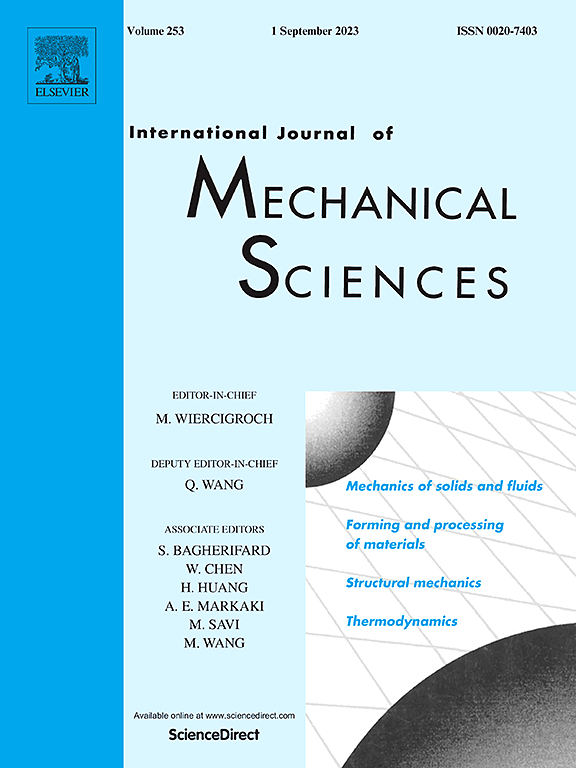Frequency-switchable edge modes in Miura-folded checkerboard metamaterials
IF 7.1
1区 工程技术
Q1 ENGINEERING, MECHANICAL
International Journal of Mechanical Sciences
Pub Date : 2025-07-20
DOI:10.1016/j.ijmecsci.2025.110589
引用次数: 0
Abstract
Miura-ori is a space-efficient paper folding shape, characterized by its doubly corrugated geometry along two orthogonal directions. Despite the rich tunability of its geometrical properties, the design of Miura-ori to realize topological edge states is still in its infancy. In our work, by optimally adjusting the folding angle and the acute angle of the Miura-folded metamaterials, we conduct the Dirac cone engineering by inducing a double Dirac cone in the band structure. We then show the emergence of a complete band gap by breaking the intrinsic glide reflection symmetry of the Miura-ori in two distinct ways, leading to configurations with opposite topological phases labeled as the inverted and everted models. Combining these two metamaterials forms edge modes propagating along the interfaces and boundaries. Especially, we demonstrate the frequency-switchable edge modes in a Miura-folded checkerboard metamaterial consisting of the two opposite topological phases, controlling several edge routing types. The edge mode switching in Miura-folded metamaterials hold significant potentials in edge wave control and energy harvesting in origami structures.三浦折叠棋盘超材料的可频率切换边缘模式
Miura-ori是一种节省空间的折纸形状,其特点是沿着两个正交方向的双重波纹几何形状。尽管Miura-ori的几何特性具有丰富的可调性,但其实现拓扑边缘状态的设计仍处于起步阶段。在我们的工作中,我们通过优化调整miura折叠的超材料的折叠角和锐角,通过在带结构中引入双狄拉克锥来进行狄拉克锥工程。然后,我们以两种不同的方式通过打破Miura-ori的固有滑动反射对称性来展示完整带隙的出现,从而导致具有相反拓扑相位的构型,标记为倒置模型和everted模型。结合这两种超材料形成沿界面和边界传播的边缘模式。特别是,我们展示了由两个相反的拓扑相组成的miura折叠棋盘超材料中的频率可切换边缘模式,控制几种边缘路由类型。三浦折叠超材料的边缘模式切换在折纸结构的边缘波控制和能量收集方面具有重要的潜力。
本文章由计算机程序翻译,如有差异,请以英文原文为准。
求助全文
约1分钟内获得全文
求助全文
来源期刊

International Journal of Mechanical Sciences
工程技术-工程:机械
CiteScore
12.80
自引率
17.80%
发文量
769
审稿时长
19 days
期刊介绍:
The International Journal of Mechanical Sciences (IJMS) serves as a global platform for the publication and dissemination of original research that contributes to a deeper scientific understanding of the fundamental disciplines within mechanical, civil, and material engineering.
The primary focus of IJMS is to showcase innovative and ground-breaking work that utilizes analytical and computational modeling techniques, such as Finite Element Method (FEM), Boundary Element Method (BEM), and mesh-free methods, among others. These modeling methods are applied to diverse fields including rigid-body mechanics (e.g., dynamics, vibration, stability), structural mechanics, metal forming, advanced materials (e.g., metals, composites, cellular, smart) behavior and applications, impact mechanics, strain localization, and other nonlinear effects (e.g., large deflections, plasticity, fracture).
Additionally, IJMS covers the realms of fluid mechanics (both external and internal flows), tribology, thermodynamics, and materials processing. These subjects collectively form the core of the journal's content.
In summary, IJMS provides a prestigious platform for researchers to present their original contributions, shedding light on analytical and computational modeling methods in various areas of mechanical engineering, as well as exploring the behavior and application of advanced materials, fluid mechanics, thermodynamics, and materials processing.
 求助内容:
求助内容: 应助结果提醒方式:
应助结果提醒方式:


